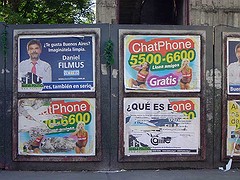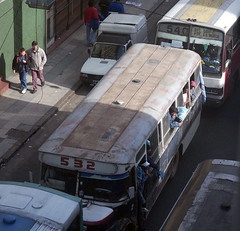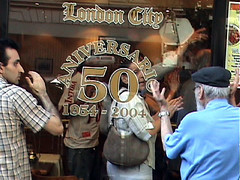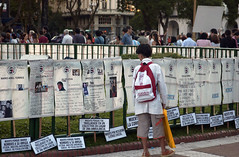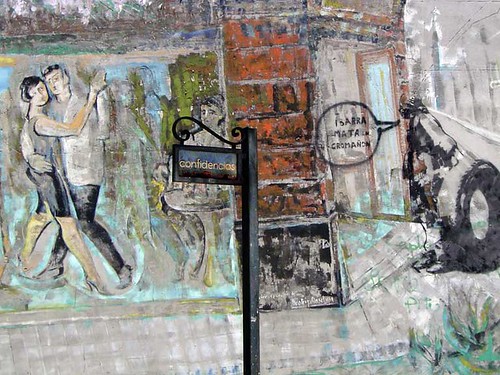Just past noon on Tuesday I wandered up to the center of the city to see what was happening around the city legislature building as the political trial of Buenos Aires mayor Anibal Ibarra over the Cromagnon tragedy reached its conclusion.
The crowd turnout was rather small, particularly considering the massive size of many demonstrations in Buenos Aires. There were two clear fractions to yesterday’s gathering and the police did a good job of making sure that the two opposition groups were separated.
The pro-Ibarra forces were in front of the Cabildo where Diagonal Sur enters Plaza de Mayo, just in front of the legislature building. The families of victims from Cromagnon were on Av de Mayo at the pedestrian intersection of calle Peru, which also leads to to legislature building. The arrangement ensured that neither group was visible to the other. Two rows of several dozen policemen blocked off Av de Mayo in front of the plaza just in case the groups decided to approach each other. However, individual pedestrians could easily pass through the police line between the two areas.
While I stayed mostly on the shadier Av de Mayo, I found myself going back-and-forth quite a bit between the two groups. About eight minutes before one p.m., when the proceedings were to start, Ibarra arrived in a small motorcade to the cheers of his supporters.
Ibarra’s supporters waved a number of signs stating that this vote was a golpe, a coup, of the government. Pictures of Mauricio Macri, Ibarra’s political opponent whom many believe is orchestrating events, were on some of the signs.
On the Cromagnon side, most of the people gathered were family and friends of the victims. Most of the parents had gathered in the cafes along Av de Mayo to watch the proceedings on TV. Others crowded around the windows along the street to watch the TV coverage. Occasional passers-by would stop and ask about the vote.
Early in the afternoon a group of young people, mostly university students, came marching down – of all places – calle Florida to join the Cromagnon crowd. They were carrying banners of the Workers Party and the Revolutionary Communist Party, as well as FUBA, the student federation from the University of Buenos Aires.
Amusingly, at the very same time, a group of Asian tourists walking down Av de Mayo came to a complete standstill when they saw the red communist flags complete with hammer and sickle. The Asians looked perplexingly at each other as they absorbed the situation. Eventually, they decided to turn around and head back in the direction from which they came.
I assume that many of the young people were friends of people who died in the Cromagnon fire. Others likely came out of a sense of identity with those who died, most of whom were also young. Others, with their flags of the far-left, likely came out of a sense of youthful idealism.
After four hours of waiting, the tenth and deciding vote against Ibarra was cast. The street erupted in applause. The photo was taken outside of the London City Cafe just moments after the final vote.
Families came out of the cafes with tears in their eyes. A woman dropped to her knees in the middle of Av de Mayo. A gray haired man around fifty walked away from the crowd and covered his face to hide his tears. The vote gave the families a brief, fleeting sense of justice, whatever they may be, but there can never be justice in the case of Cromagnon. While parts of the crowd were exuberant in jubilation, it was obvious that the families were thinking more about their loss loved ones rather than Ibarra.
Now, they wait for the criminal trials of Omar Chaban, the nightclub owner, and Callejeros, the band that was playing in Cromagnon that night.
